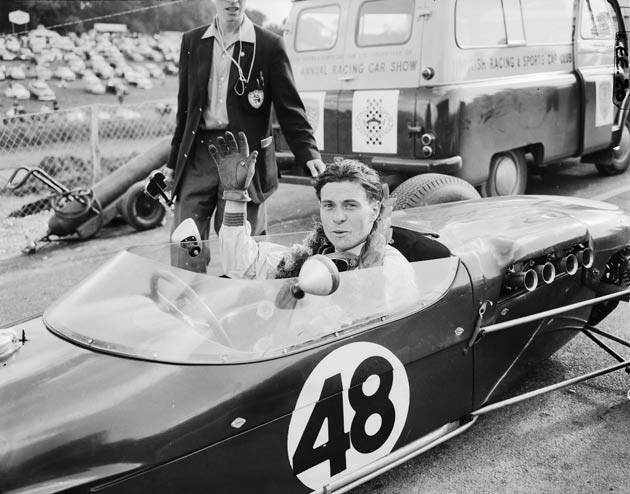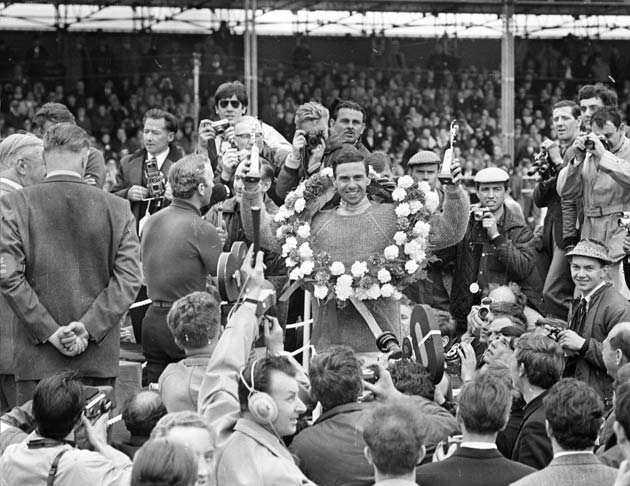Jim Clark was peerless in life, both on and off the track, and remains so half a century after his death
The iconic Scot was killed by a puncture during the wet Formula 2 Deutschland Trophy race at Hockenheim, after his Lotus crashed into unforgiving trees by the side of the track

Your support helps us to tell the story
From reproductive rights to climate change to Big Tech, The Independent is on the ground when the story is developing. Whether it's investigating the financials of Elon Musk's pro-Trump PAC or producing our latest documentary, 'The A Word', which shines a light on the American women fighting for reproductive rights, we know how important it is to parse out the facts from the messaging.
At such a critical moment in US history, we need reporters on the ground. Your donation allows us to keep sending journalists to speak to both sides of the story.
The Independent is trusted by Americans across the entire political spectrum. And unlike many other quality news outlets, we choose not to lock Americans out of our reporting and analysis with paywalls. We believe quality journalism should be available to everyone, paid for by those who can afford it.
Your support makes all the difference.Fifty years ago today, what Jackie Stewart described as an atomic bomb in the world of motorsport exploded when Jim Clark lost his life at Hockenheim in Germany.
The two Scots were close friends, and three years earlier when Stewart had arrived in F1, he played the Robin role to Clark’s undisputed Batman.
“Jim Clark,” he says still, “was everything I aspired to be, as a racing driver and as a man.”
After cutting his teeth at Team Lotus in 1960, Clark began matching Stirling Moss’s speed in the second half of the 1961 season, and took over the Englishman’s mantle in 1962 when Moss was injured in a crash at Goodwood on Easter Monday.

He narrowly lost the World Championship that year to BRM rival Graham Hill, after his Lotus developed an oil leak while dominating the finale in South Africa. Two years later he lost another championship to an oil leak, literally on the last lap of the season-closing Mexican GP. The honours fell instead to John Surtees. But in 1963 and 1965 Clark was unstoppable in Colin Chapman’s green and yellow Lotuses, and their driver/engineer relationship was symbiotic.
Clark became the greatest driver of his time, the man by whom others judged themselves. He drove with a consummate skill, precision and economy that left even rivals of the calibre of Stewart, Surtees, Hill, Dan Gurney and Jack Brabham trailing. Yet he was genuinely at a loss to explain why he was their master.
In 1963 only some obfuscation by the establishment at Indianapolis Motor Speedway in favour of the traditional front-engined roadsters prevented him from beating Parnelli Jones to victory on his debut in Chapman’s rear-engined Lotus ‘funny car’. He led the 1964 race before his rear suspension broke, and in 1965 dominated the event and became the first Briton to win since Dario Resta in 1916. He is the only man in history to have won the World Championship and the famed Indianapolis 500 in the same year.
Out of the cockpit he bit his fingernails incessantly and was famed for his inability to make even simple decisions, such as where to eat or what movie to see. But it was because he was so peerless when he had a steering wheel in his hands, and so rarely took risks, that his death had such a massive impact.

Back in the days when the British government leached up to 97 per cent from a race driver’s income, yet he had at least a 30 per cent chance of dying at the wheel, tragedies were commonplace. Some prodded the tiger once too often and ran out of luck. But not Clark. He used his tyres and brakes more frugally than any of his rivals, and rarely stressed his fragile machinery to the point where it broke.
He was the best of the best, the man of whom Fangio himself had said in 1967: “Jim Clark is outstandingly the greatest Grand Prix driver of all time.”
So when he was killed by a puncture during the wet Formula 2 Deutschland Trophy race at Hockenheim, after his Lotus crashed into unforgiving trees by the side of the track, race drivers around the world felt death’s hand on their shoulder, and asked themselves, “If it can happen to Jim Clark, what chance do we have?”
Their grief was born from self-serving instincts, but also because his innate Scottish humility, bred during his farming upbringing in the Border regions, made him hugely popular despite his towering success. He was as gracious in defeat as he was in victory, and perhaps nothing epitomised that more than at Indianapolis in 1966. To the astonishment of seasoned observers, he spun his difficult Lotus through 360 degrees, not once but twice, yet got away with both incidents thanks to his brilliant car control. Believing he had still won, he headed to Victory Lane only to find Graham Hill’s Red Ball Lola already there, his rookie rival preparing to quaff the victor’s dairy product.

Eventually, Chapman and sponsor Andy Granatelli accepted that they had made a lap-counting error. Clark, meanwhile, had sidled up to his old friend, and asked if there really was a chance that he himself had won.
“No way, mate. I drank the milk.” Hill replied. And there Clark was content to leave it.
At his funeral, Jim Clark Snr told Gurney he was the only man his son had feared. Gurney, who died in January this year, spoke of Clark thus: “It is certainly an honour to have had the opportunity to know him as a team-mate, a friend, and to have competed with him on so many memorable occasions.
“Jim whipped us so many times that we all sort of got used to it. Naturally, we didn’t like being whipped, but, it is probably a testimony to Jim’s integrity and stature among us, his peers, that we couldn’t help loving the lad in spite of it.”
Elizabeth ‘Widdy’ Cameron, whom Clark nearly married in 1960, and with whom he stayed close despite his growing global fame, said: “He was very shy. And he was a terrific gentleman. I didn't hear him say bad things about anybody. He was a good, good man and I hope everybody remembers that. He was very special.”
Arguably, he was the most versatile driver of his time and his personal gamut ran from autotests, autocross, sprints and hillclimbs to junior single seaters, F1, sportscars, saloon cars, rallying, NASCAR and Indycars. But he was never so big that he didn’t feel that he could learn from new situations. His performance in a Lotus-Cortina, for example, stunned the Scandinavians on the 1966 RAC Rally.
He simply loved racing, and that was why so many spectators loved him.
No driver before or since has so comprehensively embraced all of the factors - driving skill, intellect, versatility, adaptability, loyalty, personality, ethics, integrity, curiosity, love of the sport and humility. Jim Clark was peerless in life, and remains so half a century after his death.
Join our commenting forum
Join thought-provoking conversations, follow other Independent readers and see their replies
Comments